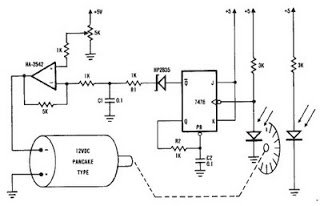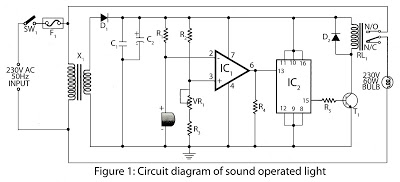
touch free timer switch circuit

This type of infrared proximity circuit is commonly utilized as an electric switch where physical contact is undesirable for hygiene reasons. For instance, infrared proximity sensors are frequently found in public drinking fountains and washrooms. The straightforward circuit described here can be activated by moving a hand in front of it. This is accomplished by detecting the infrared light reflected by the hand onto a receiver device. The circuit consists of two sections: a transmitter and a receiver. The infrared transmitter is constructed using the LMC555 timer (IC1), configured as an astable multivibrator. This multivibrator generates 38 kHz pulses (at a low duty cycle) to drive an infrared LED (LED1). The frequency can be adjusted with a 10-kilo-ohm preset (VR1). A 220-ohm series resistor (R3) ensures that the current consumption of the IR transmitter remains within acceptable limits. The receiver section incorporates the TSOP1738 IR receiver module (IRX1), another LMC555 timer (IC2), and several discrete components. The TSOP1738 is a miniaturized integrated receiver designed for infrared remote control applications, containing all necessary components for IR signal processing, including a PIN diode and preamplifier, within a single package that also acts as an IR filter. When a short IR burst is detected by IRX1 (as a hand is waved in front of the switch), the demodulated pulses are sent to the trigger input (pin 2) of the second LMC555 (IC2). This triggers the monostable configuration of IC2, causing its output pin 3 to go high for a duration determined by a 2.2-mega-ohm potentiometer and capacitor C5. This action turns off the standby indicator (LED1), allowing transistor T1 to conduct and activate a 5V relay (RL1). LED1 serves as a locator for the switch in low-light conditions. The AC mains supply to the load being switched is routed through the normally-open contacts of RL1, as illustrated in the schematic. The circuit operates on regulated 5V DC. The pin configurations for the TSOP1738, IR LED1, and transistor BC547 are depicted in the accompanying figures. The circuit should be assembled on a general-purpose PCB and housed in a compact plastic enclosure. The IR LED1 should be positioned with a reflecting hood at a recessed location on the front panel, while the dome-shaped face of the TSOP1738 should protrude slightly. The time-control potentiometer (VR2) should be placed appropriately, and the standby indicator LED1 should be mounted in a holder that allows it to slightly extend from the front panel. To minimize unwanted IR beam reflections, the unit should be installed away from nearby walls. By utilizing a high-precision linear potentiometer (VR2) and a 100 µF timing capacitor (C5), the timing duration can be adjusted from approximately 1 second to 120 seconds. A small paper dial can be affixed to the front panel, marking various positions of the control knob for VR2. The accuracy of the timer is primarily influenced by the quality and value of the timing capacitor C5. It is important to note that most electrolytic capacitors are rated based on a minimum guaranteed value, and the actual value may vary higher.
The infrared proximity circuit operates on the principle of detecting the reflection of modulated infrared light. The astable multivibrator configuration of the LMC555 timer generates a continuous square wave signal, which is transmitted via the infrared LED. The frequency of 38 kHz is chosen because it is typically less susceptible to interference from ambient light sources, making it ideal for proximity detection applications.
In the receiver section, the TSOP1738 module demodulates the incoming infrared signal. This module is designed to recognize the specific frequency of the transmitted signal, thus ensuring that only relevant signals trigger the output. The output of the TSOP1738 is fed into the trigger pin of the second LMC555 timer, which is configured in monostable mode. The duration for which the output remains high is adjustable, allowing for flexibility in the circuit's response time.
Transistor T1 acts as a switch to control the relay RL1, which can handle higher load currents, allowing the circuit to control various devices such as lights or pumps without direct contact. The design emphasizes safety and hygiene, making it suitable for public installations. Proper assembly and enclosure design are crucial for the performance and reliability of the circuit, particularly in environments where it will be exposed to varying light conditions and potential physical obstructions.This type of infrared proximity circuit is widely used as an electric switch where physical contact is not desired for hygiene purpose. For example, we commonly see use of infrared proximity sensors on public drinking fountains and in public washrooms.
The simple circuit presented here can be operated by moving your hand in front of it. This is ac hieved by detecting the infrared light reflected by your hand onto a receiver device. Fig. 1 shows the circuit of the touch-free timer switch. It has two sections: transmitter and receiver. The IR transmitter is built around timer LMC555 (IC1), which is wired as an astable multivibrator. The multivibrator produces 38kHz pulses (at low duty cycle) that drive an infrared LED (LED1). This frequency can be tuned using a 10-kilo-ohm preset (VR1). A 220-ohm series resistor (R3) ensures that the current consumption of the IR transmitter is not out of arrangement. The receiver section is built around IR receiver module TSOP1738 (IRX1), timer LMC555 (IC2) and a few discrete components.
The TSOP1738 is an integrated miniaturised receiver for infrared remote control systems. Everything required for IR signal processing, including the PIN diode and preamplifier, are assembled on a lead frame and the epoxy package is designed as an IR filter. When a short IR burst is received by IRX1 (as you wave your hand in front of the switch), the demodulated pulses are fed to the trigger input (pin 2) of the second LMC555 (IC2).
This, in turn, triggers the monostable wired around IC2 and its output pin 3 goes high for a period determined by the 2. 2-mega-ohm potentiometer and capacitor C5. This turns off the standby indicator (LED1) and transistor T1 conducts to drive the 5V relay (RL1). LED1 enables you to locate the switch in the dark. AC mains supply to the load to be switched-on is routed through the pole and normally-opened contacts of RL1 as shown in the diagram.
The circuit works off regulated 5V DC. Fig. 2 shows the pin configurations of TSOP1738, IR LED1 and transistor BC547. Assemble the circuit on a general-purpose PCB and enclose in a small plastic cabinet. Fit IR LED1 with a reflecting hood at a recessed position on the front panel of the enclosure. The dome-shaped face of the TSOP1738 should stick out from the front panel. Fit the time-control potentiometer (VR2) in an appropriate position. Finally, fit the standby indicator LED1 inside a suitable LED holder such that it slightly protrudes from the front panel. To prevent unwanted reflection of the IR beam, the finished unit should be mounted such that it does not face a nearby wall.
Using high-precision linear potentiometer VR2 and capacitor C5 (100 µF), the time length can be set from nearly 1 second to 120 seconds. Attach a small paper dial on the front panel of the enclosure and mark various positions of the control knob of VR2 as shown in Fig.
3. The accuracy of the timer depends mainly upon the quality (and value) of timing capacitor C5. In practice, most electrolytic capacitors are rated on the basis of minimum guaranteed value and the real value may be higher. 🔗 External reference
The infrared proximity circuit operates on the principle of detecting the reflection of modulated infrared light. The astable multivibrator configuration of the LMC555 timer generates a continuous square wave signal, which is transmitted via the infrared LED. The frequency of 38 kHz is chosen because it is typically less susceptible to interference from ambient light sources, making it ideal for proximity detection applications.
In the receiver section, the TSOP1738 module demodulates the incoming infrared signal. This module is designed to recognize the specific frequency of the transmitted signal, thus ensuring that only relevant signals trigger the output. The output of the TSOP1738 is fed into the trigger pin of the second LMC555 timer, which is configured in monostable mode. The duration for which the output remains high is adjustable, allowing for flexibility in the circuit's response time.
Transistor T1 acts as a switch to control the relay RL1, which can handle higher load currents, allowing the circuit to control various devices such as lights or pumps without direct contact. The design emphasizes safety and hygiene, making it suitable for public installations. Proper assembly and enclosure design are crucial for the performance and reliability of the circuit, particularly in environments where it will be exposed to varying light conditions and potential physical obstructions.This type of infrared proximity circuit is widely used as an electric switch where physical contact is not desired for hygiene purpose. For example, we commonly see use of infrared proximity sensors on public drinking fountains and in public washrooms.
The simple circuit presented here can be operated by moving your hand in front of it. This is ac hieved by detecting the infrared light reflected by your hand onto a receiver device. Fig. 1 shows the circuit of the touch-free timer switch. It has two sections: transmitter and receiver. The IR transmitter is built around timer LMC555 (IC1), which is wired as an astable multivibrator. The multivibrator produces 38kHz pulses (at low duty cycle) that drive an infrared LED (LED1). This frequency can be tuned using a 10-kilo-ohm preset (VR1). A 220-ohm series resistor (R3) ensures that the current consumption of the IR transmitter is not out of arrangement. The receiver section is built around IR receiver module TSOP1738 (IRX1), timer LMC555 (IC2) and a few discrete components.
The TSOP1738 is an integrated miniaturised receiver for infrared remote control systems. Everything required for IR signal processing, including the PIN diode and preamplifier, are assembled on a lead frame and the epoxy package is designed as an IR filter. When a short IR burst is received by IRX1 (as you wave your hand in front of the switch), the demodulated pulses are fed to the trigger input (pin 2) of the second LMC555 (IC2).
This, in turn, triggers the monostable wired around IC2 and its output pin 3 goes high for a period determined by the 2. 2-mega-ohm potentiometer and capacitor C5. This turns off the standby indicator (LED1) and transistor T1 conducts to drive the 5V relay (RL1). LED1 enables you to locate the switch in the dark. AC mains supply to the load to be switched-on is routed through the pole and normally-opened contacts of RL1 as shown in the diagram.
The circuit works off regulated 5V DC. Fig. 2 shows the pin configurations of TSOP1738, IR LED1 and transistor BC547. Assemble the circuit on a general-purpose PCB and enclose in a small plastic cabinet. Fit IR LED1 with a reflecting hood at a recessed position on the front panel of the enclosure. The dome-shaped face of the TSOP1738 should stick out from the front panel. Fit the time-control potentiometer (VR2) in an appropriate position. Finally, fit the standby indicator LED1 inside a suitable LED holder such that it slightly protrudes from the front panel. To prevent unwanted reflection of the IR beam, the finished unit should be mounted such that it does not face a nearby wall.
Using high-precision linear potentiometer VR2 and capacitor C5 (100 µF), the time length can be set from nearly 1 second to 120 seconds. Attach a small paper dial on the front panel of the enclosure and mark various positions of the control knob of VR2 as shown in Fig.
3. The accuracy of the timer depends mainly upon the quality (and value) of timing capacitor C5. In practice, most electrolytic capacitors are rated on the basis of minimum guaranteed value and the real value may be higher. 🔗 External reference
Warning: include(partials/cookie-banner.php): Failed to open stream: Permission denied in /var/www/html/nextgr/view-circuit.php on line 713
Warning: include(): Failed opening 'partials/cookie-banner.php' for inclusion (include_path='.:/usr/share/php') in /var/www/html/nextgr/view-circuit.php on line 713





